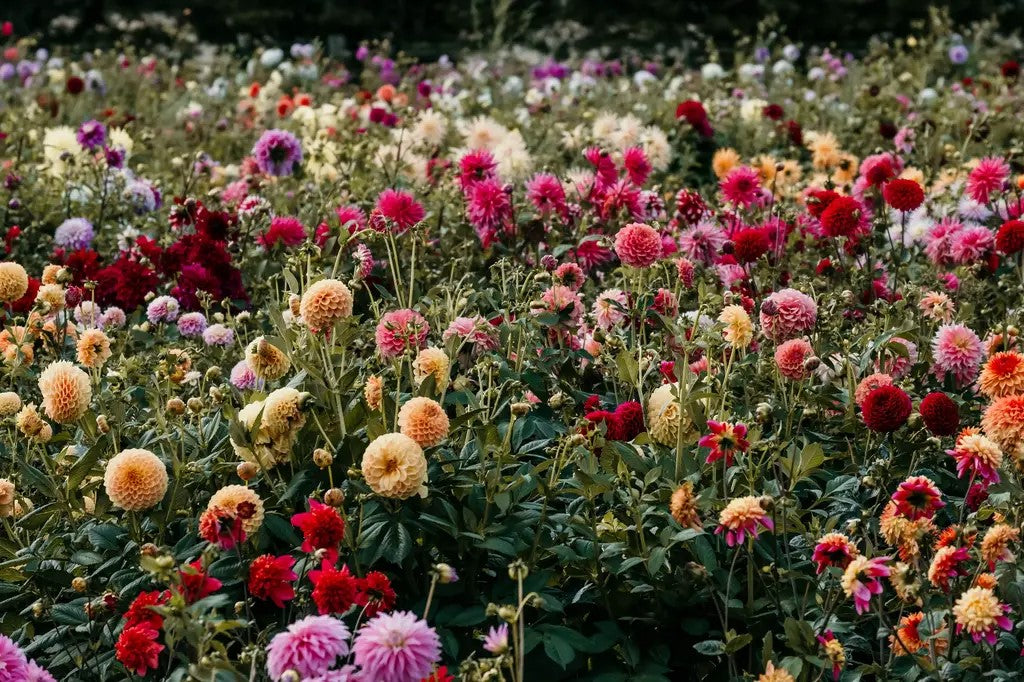
Growing Dahlias
Share
Grow
Tubers - for a tuber to be viable, they need to have a healthy body, attached neck and part of the crown from the original clump.

In spring, the tubers start to produce an eye, this is where your tuber will grow its shoots from.
Location - dahlias love a position in full sun and need at least 4-6 hours of sunlight per day to flower abundantly. Prepare the soil at least two weeks before planting.
Soil - dahlias are heavy feeders and require the soil to be full of good nutrients and the soil must be well draining. The easiest way to kill your tuber is for it to rot, so having a raised bed is very important. If the soil is suitable for vegetables, it will be excellent for dahlias.
Planting – plant in late spring, as they are frost sensitive so ensure that this is after the last frost date. Often Melbourne cup weekend is used as a measure of when to plant out dahlia’s in Australia, however they can be planted any time from September to Christmas and earlier in more tropical climates.
Do not plant your tubers into very wet soil as the tuber may rot before it shoots.
Consider using the THUMB method

Figure curiosity of Dahlia Society of Victoria
Staking – if staking your plants put the stakes into the ground immediately to avoid any tuber damage
Fertilising – Dahlias love a bit of fertiliser. Sheep and cow are best for dahlias as they are richer in potassium which helps flowering. Seaweed solutions can help against fungal diseases and insects.
Water - after you plant your tubers do not water them until the shoots appear above the soil. We water our plants twice a week depending on the weather. Keep in mind not to over water and keep the soil well drained.
Pinching - once your dahlia plant has 3-5 sets of leaves, the growing tip should be removed., to encourage lateral growths, thereby growing into a bush and producing many more blooms during the season.
Harvest
Flowers
To get the most out of your flowers, harvest before the blooms have opened fully. Remove any extra bubs on each stem as they don’t usually open and will drain energy from the primary flower.
The more you pick the blooms the more flowers the bush produces.
Deadhead your plant through out the season to encourage new flowers to bloom
Tubers
Towards the end of the flowering season, the plants gradually begin to enter dormancy. At this stage, the plants start to produce tubers.
I wait until the first frost in winter to dig my tubers. If there is no frost wait until the stem is dried and gone brown usually June/July.
Store
At this time if the tubers are lifted, they should be stored in a cool place, under eaves, or in the garage and away from sunlight ensuring that they do not dry out or freeze. Leaving the soil on will help prevent drying out. If the soil is washed off, store tubers in moist (not wet) sand or wood shavings.
Dividing
Dividing is best done with tubers have no soil on them, when it is easiest to see the eye.
Tubers can be divided by cutting into sections, with each tuber a piece of the neck where they are joined to the previous years woody stem.
The ‘eye’ where the new shoot appears may be visible when the tubers are freshly lifted.
Damaged tubers, without a piece of the neck are known as ‘blinds’ and will not grow into a new plant.
When dividing clean your tools in a bleach solution in between each clump to reduce the spread of viruses
Learn more about storing dahlias, here. Note that if you don’t want to bother digging them up, that’s okay. One plant makes so many blooms in a season that many consider dahlias worth the annual investment. If you want to learn more about whether or not to dig up your dahlias, here is a YouTube video.
Tips for best results:
- Size of the tuber is not an indication of better growth potential; a smaller tuber is often better because it will grow roots more quickly, thereby establishing easier.
- Dahlia seeds are not true to type and by planting your own seed you will create new varieties.
